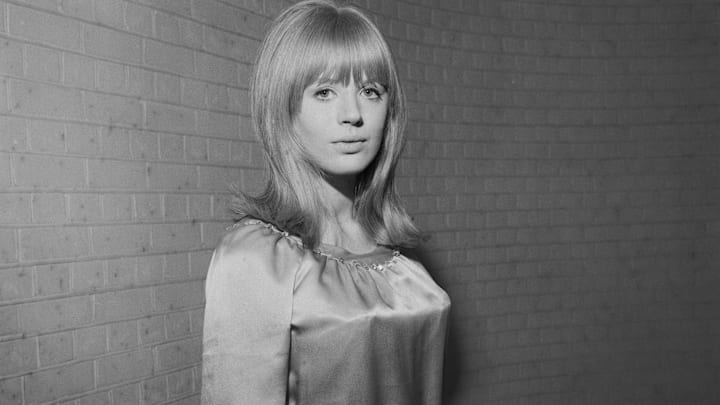From strawberry blond waif on the arm of Mick Jagger in the 1960s to a latter-day Billie Holiday, Marianne Faithfull had a remarkable journey through pop music. Faithfull, who died last Thursday at the age of 78, was a genuine rock original. She was famously discovered as a teenager by Rolling Stones manager Andrew Loog Oldham in 1964 and released her first album in April of ’65, when she was just 18 years old.
Actually, two Marianne Faithfull albums were released on that day. Marianne Faithfull was a pop album with selections from the likes of Lennon & McCartney (“I’m a Loser”), Jackie DeShannon (“Come and Stay With Me”), and Tony Hatch (“Downtown”). But Faithfull preferred traditional folk songs, and so Come My Way was filled with folk standards like “House of the Rising Sun,” “Fare Thee Well” and Lee Hays’ ”Lonesome Traveler.”
One other song from Marianne Faithfull was co-written by Oldham, along with Mick Jagger and Keith Richards. Her sweet reading of the Stones’ “As Tears Go By” became her first hit, breaking into the Top Ten in the UK and the Top 25 in the USA. “Come and Stay With Me” would perform even better.
Marianne Faithfull passed away last week at age 78
She would release four more albums – two in the UK and two others in the States – in the latter half of the ‘60s, but her singing career was largely overshadowed by her well-publicized relationship with Jagger.
The albums were uneven, blending her pop and folk impulses, but they yielded enough strong songs to result in a fine Greatest Hits album in 1969, including a harrowing version of of song she co-wrote with Jagger and Richards, “Sister Morphine,” and which hinted at a troubled soul beneath those ultra-cool cover girl looks. Faithfull may not have been the singer that Jagger was in the 1960s, but her versions of “As Tears Go By” and “Sister Morphine” rival and quite possibly surpass the Stones.
She also launched an acting career in the late ‘60s, playing Ophelia in Tony Richardson’s Hamlet and famously donning leather in the X-rated The Girl on the Motorcycle.
Then came her period of darkness. For the first half of the 1970s, Faithfull, now separated from Jagger, was plagued by myriad personal problems. A suicide attempt, heroin addiction, and homelessness very nearly ended her life, but she would return a changed artist.
It began with her country album Dreamin’ My Dreams in 1976. The voice, which was starting to turn raspy in the late ‘60s, now sounded transformed. It was older, wiser, and full of a lifetime’s worth of pain and experience. She was about to turn thirty.
Songs like “Lady Madelaine” and “I’m Not Lisa” from Dreamin’ My Dreams had a rawness to them, but nothing prepared the public for what came next. In 1979, Broken English was Faithfull’s masterpiece.
Her devastating version of the fractured suburban psyche, “The Ballad of Lucy Jordan,” written by Shel Silverstein, was four minutes of stunning heartbreak. She did John Lennon better than the man himself in “Working Class Hero.” The politically charged titled track could have been the Clash.
And the closing track, “Why d’Ya Do It?” was just as punk as anything being performed by the Sex Pistols or the Slits at the time. The graphic nature of her lyrics prevents me from quoting them here. Give it a listen if that intrigues you.
Faithfull struggled to build on Broken English, still experimenting with varied genres in the years to come. It wasn’t until 1999 that she teamed up with producer Daniel Lanois and Roger Waters to release Vagabond Ways, featuring songs from Waters, Leonard Cohen, and Bob Dylan, among others. By this point, Faithfull was among the most unique voices in music, channeling former stars the likes of Billie Holiday. One syllable was all it took to identify Marianne Faithfull.
In later years, she seemed to work with a who’s who at the cutting edge of different rock genres – from John Prine and Steve Earle to Damon Albarn and Beck - and she eventually released the powerhouse Give My Love to London in 2014.
A few years later, she released the equally potent Negative Capability, with help from Nick Cave and Warren Ellis, who had become some of her finest collaborators. The album featured a newly recorded version of “As Tears Go By,” the song that launched her as a teenager. It is a stunning companion piece to the original.
In 2021, after recovering from a bout of Covid that very nearly took her life, Faithfull teamed up with Ellis again for what would prove to be her final studio album. On She Walks in Beauty, she intones poems from the likes of Byron, Keats, and Shelley over the soundscapes created by Ellis, along with help from Cave and Brian Eno.
Those are artists at the forefront of musical exploration – and they all wanted to be involved with Marianne Faithfull. A voice like that just doesn’t come along very often.
